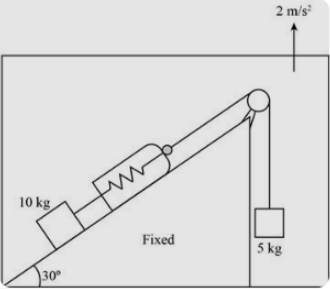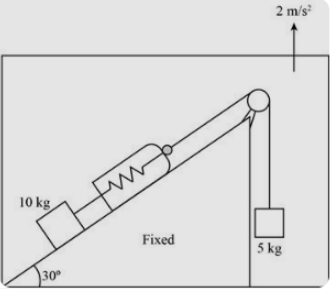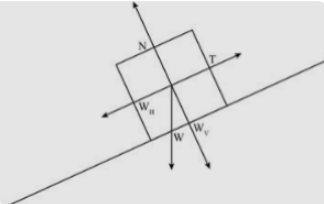
In the given figure find the reading of the spring balance (Assuming that the extension of the spring is not changing) and the inclined plane is smooth, Also assume the pulley, string and the box of the spring are light,

A.
B.
C.
D.

Answer
474.9k+ views
2 likes
Hint:The reading on the spring balance would be equal to the tension in the string. Net gravity experienced would be greater than the actual value as the lift is moving up.
Complete step by step answer:
If we look at the figure, we can see that the whole system is placed inside a lift. And the lift is going upwards. So, we are dealing with a non-inertial system and the whole apparatus has to be solved in a non-inertial frame of reference. But the problem with that is that Newton's laws of motion are not valid in non-inertial frames. So, we need to bring in the correction factors to make the system susceptible to Newton's laws.This can be done with the introduction of a pseudo acceleration in the opposite direction to the system's actual acceleration.
Hence the downward acceleration of the bodies inside the elevator will be increased by the same amount of acceleration in which it is moving up, to cancel its effect
Hence, the weight experienced by a body inside the elevator will be
The spring balance is attached to a string with two blocks of weight at both ends, while the lighter block is completely hanging on the string, it’s not the same with the heavier block, the weight of the heavier block is distributed within the wedge and the string.We need to find the component of its weight acting on the string. Let us have a look at the diagram

Drawing the free body diagram of the heavier block we get

As we can see the horizontal component (horizontal to the wedge) is balancing the tension.
Also, the force created by the lighter block will be
As we can see both the forces are equal and hence both blocks will be in equilibrium. Hence tension would be equal to the magnitude of those forces.
Mathematically
Hence the tension is
Thus, option C is the correct answer.
Note:Because of the motion of elevator net acceleration would increase. Drawing free body diagrams would make it easier to solve the question.Moreover, while Newton’s laws of motion may seem obvious to us today, centuries ago they were considered revolutionary. The three laws of motion help us understand how objects behave when they are standing still, when moving and when forces act upon them.
Complete step by step answer:
If we look at the figure, we can see that the whole system is placed inside a lift. And the lift is going upwards. So, we are dealing with a non-inertial system and the whole apparatus has to be solved in a non-inertial frame of reference. But the problem with that is that Newton's laws of motion are not valid in non-inertial frames. So, we need to bring in the correction factors to make the system susceptible to Newton's laws.This can be done with the introduction of a pseudo acceleration in the opposite direction to the system's actual acceleration.
Hence the downward acceleration of the bodies inside the elevator will be increased by the same amount of acceleration in which it is moving up, to cancel its effect
Hence, the weight experienced by a body inside the elevator will be
The spring balance is attached to a string with two blocks of weight at both ends, while the lighter block is completely hanging on the string, it’s not the same with the heavier block, the weight of the heavier block is distributed within the wedge and the string.We need to find the component of its weight acting on the string. Let us have a look at the diagram

Drawing the free body diagram of the heavier block we get

As we can see the horizontal component (horizontal to the wedge) is balancing the tension.
Also, the force created by the lighter block will be
As we can see both the forces are equal and hence both blocks will be in equilibrium. Hence tension would be equal to the magnitude of those forces.
Mathematically
Hence the tension is
Thus, option C is the correct answer.
Note:Because of the motion of elevator net acceleration would increase. Drawing free body diagrams would make it easier to solve the question.Moreover, while Newton’s laws of motion may seem obvious to us today, centuries ago they were considered revolutionary. The three laws of motion help us understand how objects behave when they are standing still, when moving and when forces act upon them.
Latest Vedantu courses for you
Grade 10 | CBSE | SCHOOL | English
Vedantu 10 CBSE Pro Course - (2025-26)
School Full course for CBSE students
₹37,300 per year
Recently Updated Pages
Master Class 9 General Knowledge: Engaging Questions & Answers for Success

Master Class 9 English: Engaging Questions & Answers for Success

Master Class 9 Science: Engaging Questions & Answers for Success

Master Class 9 Social Science: Engaging Questions & Answers for Success

Master Class 9 Maths: Engaging Questions & Answers for Success

Class 9 Question and Answer - Your Ultimate Solutions Guide

Trending doubts
State and prove Bernoullis theorem class 11 physics CBSE

What are Quantum numbers Explain the quantum number class 11 chemistry CBSE

Who built the Grand Trunk Road AChandragupta Maurya class 11 social science CBSE

1 ton equals to A 100 kg B 1000 kg C 10 kg D 10000 class 11 physics CBSE

State the laws of reflection of light

One Metric ton is equal to kg A 10000 B 1000 C 100 class 11 physics CBSE




